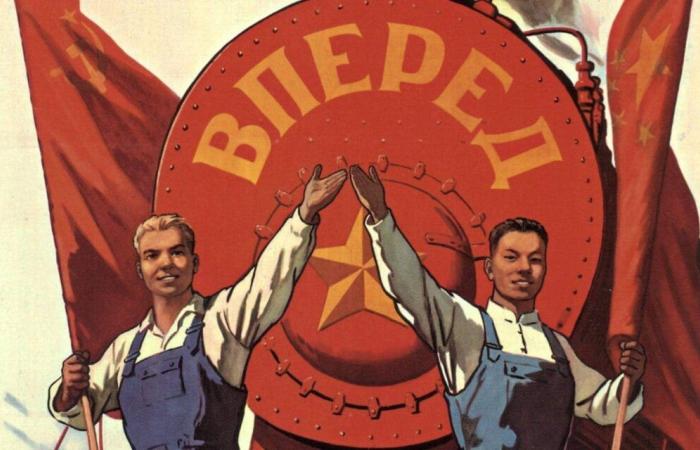In April 1917, while hiding in Finland to escape the arrest warrant of the provisional government, Lenin wrote a pamphlet entitled The state and the Revolution. In him, Lenin promised to defend the imminent violent taking of power by the Bolsheviks using Marx and Engels’ texts about the advent of socialism and the commune of Paris. He also described in great detail the system that would follow the socialist revolution in Russia. In the economic field, it would consist of the nationalization of the means of production, the abolition of private property and the centralization of decision making. In the political sphere, it would be the dictatorship of the proletariat and the power of the Soviets. The dictatorship of the proletariat must be understood here in its social context, in the same way that, according to Marx, all capitalist regimes are dictatorships of the capitalists, regardless of whether they have a multiparty democratic coverage or are governed by authoritarian governments. In the strict sense, the dictatorship of the proletariat, as Lenin conceives it, is compatible with both the multi -party system and with the Unipartisan system.
In April 1922, exactly five years later, Lenin, now head of the Soviet government, delivered his last and long speech before the XI Congress of the Russian Communist Party. It defended the new economic policy (NEP), which was largely probitalist and was being attacked by several powerful factions of the Bolshevik party (the so -called workers’ opposition, led by Shlyopnikov, and supporters of forced industrialization, represented by Preobrazhensky). The policies of the NEP were diametrically opposed to those that Lenin had outlined in 1917.
There are several aspects that can be highlighted when comparing both documents. The first is the evolution of Lenin’s thought during those five years, which shows him as a brilliant politician. Although he maintained the final objective, he completely changed his tactic as circumstances evolved. The second is the relevance of both texts for the current situation. The State and the Revolution It can be read as a manual on how to take power and change the internal structure of the State. While the Trumpist revolution in the United States does not have the class content that Lenin foresaw for the Soviet revolution, dogs undertakes a similar attempt to change the deep ideology of the State and make the new state follow the interests of the new rulers. Lenin explains:
The revolution consists of … destroying the “administrative apparatus” and all the state machinery, replacing it with a new one … abolishing the bureaucracy once, everywhere and completely, it is impossible. It is a utopia. But once the old bureaucratic machine is destroyed and immediately start building a new one … that is not a utopia.
The 1922 speech, on the other hand, can be read as a summary and as a Praisal from the front of the policies applied by the Chinese government during the last forty years: introduction of capitalism to reinforce the single party regime and, ultimately, to bring society to socialism. It is socialism by capitalist media.
Lenin’s two texts are remarkably different in style. In The State and the RevolutionLenin is very strictly swallowed to Marx and, especially, Engels, and uses countless appointments to establish his adherence to doctrine and justify the political coup. The text is full of Engels citations, which was more frank, or perhaps more bloodthirsty, than Marx by calling the use of violence in revolutions. It is a dogmatic work, although excellently written. Try to convince the outstanding figures of the second and second and average international of Lenin’s evaluation about the Great war and how successful his call to transform war between capitalist states into a war of socialist revolution.
The reality of the construction of socialism was not as easy as Lenin expected in April 1917. Thus, five years later, after the civil war, the communism of war, foreign military interventions and Kronstadt’s rebellion, Lenin’s approach on the construction of socialism had changed. The speech before the XI Congress is remarkable for its qualities opposed to those of The State and the Revolution. It is an absolutely non -dogmatic document, a underlined feature not only for the absence of Marx appointments, but, in several cases, for decisive statements that the new system built in the Soviet Russia is something that Marx could not imagine, did not foresee and, therefore, about what he left no opinion. It is as if Paul told Jesus to ignore some things.
The new system could be reconciled, as Lenin then argued and today the Chinese Communist Party, with the Marxist doctrine pointing out that socialist revolutions took place in the least developed parties in the world and required different means to those thought by Eurocentric Marxists:
Are the social and economic conditions of our country [Rusia] Today such that induct the royal proletarians to enter the factories? No. It would be true according to Marx; But Marx did not write about Russia; He wrote about capitalism as a whole, starting with the fifteenth century. It was true for six hundred years, but it is not for current Russia.
-
Or again
All the more or less intelligible books on state capitalism that have appeared so far were written in conditions and in a situation in which state capitalism was capitalism. Now things are different; and neither Marx nor the Marxists could foresee it. We should not look at the past.
The main objective of the 1922 speech was to defend the introduction of capitalist production relations in Soviet Russia. These relationships were presented in two ways: allow small peasant farms and the production of goods in the countryside and private trade with cities; and allow the entry of foreign capital through mixed companies owned by the Soviet state and foreign capitalists. The two are obvious deviations of the idea of socialization of the means of centralized production and planning stated by Lenin five years before.
In 1922, state capitalism was the agenda. In an ideological force tour, Lenin distinguishes state capitalism in conditions capitalist of state capitalism under conditions socialist. In the first, the State takes part in the power of the private sector to better maintain the dictatorship of capital; In the second, political power is firmly in the hands of the Communist Party, but many economic functions delegate to the capitalists to increase global production. State capitalism is nothing more than a transitory stage towards socialism. This is what the Chinese Communist Party has been saying since the reforms began in 1978. Even the structure of what was reformed in China is similar to what Lenin defended in 1922. The first Chinese reforms included the de -lectivization of agriculture and the opening of the economy to the private sector and the foreign capital.
But, although the NEP is necessary for economic reasons, according to Lenin, it should never lead to the control of capitalists about political decision making. The latter must remain centralized in the hands of the Communist Party. “State capitalism is a capitalism that we can control and whose limits we can set.”
State capitalism is a transitory stage that, once the productive forces have been released and much greater income has been obtained, could be deactivated, reversed and replaced by the original socialist policies. In other words, state capitalism is considered an additional stage in the development of capitalism to socialism, necessary by the fact that socialist revolutions occurred in less developed countries.
State capitalism does not have a temporary limit. The only temporal element that Lenin provides is the need for policies to last until the communist cadres “learn” to manage the economy much better, that is, to be as efficient as the capitalists. Therefore, Lenin’s vision is not incompatible that state capitalism lasts a hundred years, as Deng Xiaoping predicted, or even more: that “cadres” do not learn capitalist management techniques with enough quickly. This does not imply in any way that the party deviates from the ultimate goal of socialization of the means of production. It is a capitalism that can last an indefinite period under the always vigilant look of the Communist Party.
Daniel Gascón translation.
Originally published in the author’s substitute.






